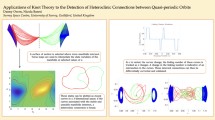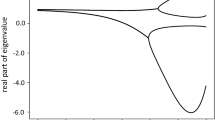Abstract
Local toroidal coordinate systems are introduced to characterize relative motion near a periodic orbit with an oscillatory mode in the circular restricted three-body problem. These coordinate systems are derived from a first-order approximation of invariant tori relative to a periodic orbit and supply a geometric interpretation that is consistent across distinct periodic orbits. First, the local toroidal coordinate sets are used to rapidly generate first-order approximations of quasi-periodic relative motion. Then, geometric properties of these first-order approximations are used to predict the minimum and maximum separation distances between a spacecraft following quasi-periodic motion relative to another spacecraft located on a periodic orbit. Implementation of the local toroidal coordinate systems and associated geometric analyses is demonstrated in the context of spacecraft formations operating near members of the Earth–Moon \(L_2\) southern halo orbit family.















Similar content being viewed by others
Availability of data and materials
No additional data or materials are provided.
References
Alfriend, K., Vadali, S.R., Gurfil, P., How, J., Breger, L.: Spacecraft Formation Flying: Dynamics, Control and Navigation, vol. 2. Chapter 4: Nonlinear Models of Relative Dynamics, pp. 59–82. Elsevier, Amsterdam (2009)
Bakhtiari, M., Daneshjou, K., Abbasali, E.: A new approach to derive a formation flying model in the presence of a perturbing body in inclined elliptical orbit: relative hovering analysis. Astrophys. Space Sci. 362(2), 36 (2017). https://doi.org/10.1007/s10509-016-2968-9
Barden, B.T., Howell, K.C.: Formation flying in the vicinity of libration point orbits. In: Advances in the Astronautical Sciences, pp. 969–988 (1998a)
Barden, B.T., Howell, K.C.: Fundamental motions near collinear libration points and their transitions. J. Astronaut. Sci. 46(4), 361–378 (1998b). https://doi.org/10.1007/BF03546387
Barden, B.T., Howell, K.C.: Dynamical issues associated with relative configurations of multiple spacecraft near the Sun-Earth/Moon L1 point. In: AAS/AIAA Astrodynamics Specialist Conference (1999)
Baresi, N., Scheeres, D.J.: Design of bounded relative trajectories in the Earth zonal problem. J. Guid. Control Dyn. 40(12), 3075–3087 (2017). https://doi.org/10.2514/1.G002603
Baresi, N., Scheeres, D.J., Schaub, H.: Bounded relative orbits about asteroids for formation flying and applications. Acta Astronaut. 123, 364–375 (2016). https://doi.org/10.1016/j.actaastro.2015.12.033
Belvin, W., Doggett, B.R., Watson, J., Dorsey, J.T., Warren, J., Jones, T.C., Komendera, E., Mann, T., Bowman, L.: In-space structural assembly: applications and technology. In: AIAA Spacecraft Structures Conference (2016)
Bennett, T., Schaub, H.: Continuous-time modeling and control using nonsingular linearized relative-orbit elements. J. Guid. Control Dyn. 39(12), 2605–2614 (2016). https://doi.org/10.2514/1.G000366
Breakwell, J.V., Brown, J.V.: The halo family of 3-dimensional periodic orbits in the Earth-Moon restricted 3-body problem. Celest. Mech. 20(4), 389–404 (1979)
Burt, J., Smith, B.: Deep space climate observatory: the DSCOVR mission. In: IEEE Aerospace Conference, Big Sky, MT (2012). https://doi.org/10.1109/AERO.2012.6187025
Calico, R.A., Wiesel, W.E.: Control of time-periodic systems. J. Guid. Control Dyn. 7(6), 671–676 (1984). https://doi.org/10.2514/3.19911
Carter, T.E.: State transition matrices for terminal rendezvous studies: Brief survey and new example. J. Guid. Control Dyn. 21(1), 148–155 (1998). https://doi.org/10.2514/2.4211
Clohessy, W.H., Wiltshire, R.S.: Terminal guidance system for satellite rendezvous. J. Aerosp. Sci. 27(9), 653–658 (1960). https://doi.org/10.2514/8.8704
Crusan, J.C., Smith, R.M., Craig, D.A., Caram, J.M., Guidi, J., Gates, M., Krezel, J.M., Herrmann, N.B.: Deep space gateway concept: extending human presence into cislunar space. In: IEEE Aerospace Conference, pp. 1–10. IEEE (2018)
Dunham, D.W., Roberts, C.E.: Stationkeeping techniques for libration-point satellites. J. Astronaut. Sci. 49(1), 127–144 (2001). https://doi.org/10.1007/BF03546340
Elliott, I., Bosanac, N.: Impulsive control of formations near invariant tori via local toroidal coordinates. In: 32nd AAS/AIAA Astrodynamics Specialist Conference (2021a)
Elliott, I., Bosanac, N.: Spacecraft formation control near a periodic orbit using geometric relative coordinates. In: 31st AAS/AIAA Spaceflight Mechanics Meeting (2021b)
Elliott, I., Bosanac, N.: Characterizing natural relative motion of formations on invariant tori in multi-body systems. In: AIAA Scitech 2022 Forum (2022)
Farquhar, R.W.: The utilization of halo orbits in advanced lunar operations. NASA Technical Note D-6365 (1971)
Farres, A., Webster, C., Folta, D.: High fidelity modeling of SRP and its effect on the relative motion of Starshade and WFIRST. In: Space Flight Mechanics Meeting (2018). https://doi.org/10.2514/6.2018-2227
Ferrari, F., Lavagna, M.: Suitable configurations for triangular formation flying about collinear libration points under the circular and elliptic restricted three-body problems. Acta Astronaut. 147, 374–382 (2018). https://doi.org/10.1016/j.actaastro.2016.08.011
Franzini, G., Innocenti, M.: Relative motion dynamics in the restricted three-body problem. J. Spacecr. Rocket. 56(5), 1322–1337 (2019). https://doi.org/10.2514/1.A34390
Gardner, J., Mather, J., Clampin, M., Doyon, R., Greenhouse, M., Hammel, H., Hutchings, J., Jakobsen, P., Lilly, S., Long, K., Lunine, J., Mccaughrean, M., Mountain, M., Nella, J., Rieke, G., Rieke, M., Rix, H.-W., Smith, E., Sonneborn, G., Wright, G.: The James Webb space telescope. Space Sci Rev 123, 485–606 (2009). https://doi.org/10.1007/s11214-006-8315-7
Gill, E., D’Amico, S., Montenbruck, O.: Autonomous formation flying for the PRISMA mission. J. Spacecr. Rocket. 44(3), 671–681 (2007). https://doi.org/10.2514/1.23015
Gómez, G., Masdemont, J., Simó, C.: Quasihalo orbits associated with libration points. JAS 46(2), 135–176 (1998)
Gurfil, P., Kasdin, N.: Stability and control of spacecraft formation flying in trajectories of the restricted three-body problem. Acta Astronaut. 54(6), 433–453 (2004)
Hazeltine, R.D., Meiss, J.D.: Plasma Confinement, Chapter 2: Review of Fundamentals, pp. 21–36. Dover Publications, New York (2003)
Henry, D.B., Scheeres, D.J.: Expansion maps: designing relative trajectories on quasi-periodic orbits. J. Guid. Control Dyn. 44(3), 457–468 (2021). https://doi.org/10.2514/1.G005492
Héritier, A., Howell, K.C.: Dynamical evolution of natural formations in libration point orbits in a multi-body regime. Acta Astronaut. 102, 332–340 (2014). https://doi.org/10.1016/j.actaastro.2013.10.017
Howell, K.C.: Three-dimensional, periodic, halo orbits. Celest. Mech. 32(1), 53–71 (1984)
Howell, K.C., Marchand, B.G.: Natural and non-natural spacecraft formations near the L1 and L2 libration points in the Sun-Earth/Moon ephemeris system. Dyn. Syst. 20(1), 149–173 (2005). https://doi.org/10.1080/1468936042000298224
Hsiao, F., Scheeres, D.: The dynamics of formation flight about a stable trajectory. J. Astronaut. Sci. 50(3), 269–287 (2002). https://doi.org/10.1007/BF03546252
Jorba, À., Masdemont, J.: Dynamics in the center manifold of the collinear points of the restricted three body problem. Phys. D Nonlinear Phenom. 132(1), 189–213 (1999). https://doi.org/10.1016/S0167-2789(99)00042-1
Kasper, J., Lazio, J., Romero-Wolf, A., Lux, J., Neilsen, T.: The Sun Radio Interferometer Space Experiment (SunRISE) Mission Concept. In: 2019 IEEE Aerospace Conference, pp. 1–11 (2019). https://doi.org/10.1109/AERO.2019.8742146
Kolemen, E., Kasdin, N., Gurfil, P.: Multiple Poincaré sections method for finding the quasiperiodic orbits of the restricted three body problem. Celest. Mech. Dyn. Astron. 112, 47–74 (2012). https://doi.org/10.1007/s10569-011-9383-x
Koon, W.S., Lo, M.W., Marsden, J.E., Ross, S.D.: Dynamical Systems, the Three-Body Problem and Space Mission Design. Marsden Books (2006)
Le Moigne, J.: Distributed spacecraft missions (DSM) technology development at NASA Goddard Space Flight Center. In: Institute of Electrical and Electronics Engineers International Geoscience and Remote Sensing Symposium, pp. 293–296 (2018). https://doi.org/10.1109/IGARSS.2018.8519065
Lo, M.W.: Satellite-constellation design. Comput. Sci. Eng. 1, 58–67 (1999). https://doi.org/10.1109/5992.743623
McCarthy, B.P., Howell, K.C.: Leveraging quasi-periodic orbits for trajectory design in cislunar space. Astrodynamics 5(2), 139–165 (2021). https://doi.org/10.1007/s42064-020-0094-5
McCartin, B.J.: A matrix analytic approach to conjugate diameters of an ellipse. Appl. Math. Sci. 7(36), 1797–1810 (2013)
Meiss, J.D.: Differential Dynamical Systems, Chapter 9: Hamiltonian Dynamics, pp. 333–391 (2007)
Montenbruck, O., Kahle, R., D’Amico, S., Ardaens, J.-S.: Navigation and control of the TanDEM-X formation. J. Astronaut. Sci. 56(3), 341–357 (2008)
Noble, B., Daniel, J.W.: Applied Linear Algebra. Prentice-Hall, Englewood Cliffs (1969)
Olikara, Z.P., Scheeres, D.J.: Numerical methods for computing quasi-periodic orbits and their stability in the restricted three-body problem. In: Advances in the Astronautical Sciences, pp. 911–930 (2012)
Roscoe, C.W., Vadali, S.R., Alfriend, K.T.: Third-body perturbation effects on satellite formations. J. Astronaut. Sci. 60(3), 408–433 (2013). https://doi.org/10.1007/s40295-015-0057-x
Schaub, H.: Relative orbit geometry through classical orbit element differences. J. Guid. Control Dyn. 27(5), 839–848 (2004). https://doi.org/10.2514/1.12595
Schaub, H., Junkins, J.: Analytical mechanics of space systems, Chapter 14: Spacecraft Formation Flying, pp. 709–792. AIAA Education Series. American Institute of Aeronautics and Astronautics, Incorporated (2014). https://doi.org/10.2514/4.102400
Scheeres, D.J., Hsiao, F.-Y., Vinh, N.X.: Stabilizing motion relative to an unstable orbit: applications to spacecraft formation flight. J. Guid. Control Dyn. 26(1), 62–73 (2003). https://doi.org/10.2514/2.5015
Schnizer, P., Fischer, E., Schnizer, B.: Cylindrical circular and elliptical, toroidal circular and elliptical multipoles fields, potentials and their measurement for accelerator magnets. arXiv:1410.8090 (2014)
Seeger, M., Hetzel, A., Dai, Z., Meissner, E., Lawrence, N.D.: Auto-differentiating linear algebra. arXiv:1710.08717 (2017)
Sengupta, P., Vadali, S.R.: Relative motion and the geometry of formations in Keplerian elliptic orbits with arbitrary eccentricity. J. Guid. Control Dyn. 30(4), 953–964 (2007). https://doi.org/10.2514/1.25941
Short, C.R., Blazevski, D., Howell, K.C., Haller, G.: Stretching in phase space and applications in general nonautonomous multi-body problems. Celest. Mech. Dyn. Astron. 122, 213–238 (2015). https://doi.org/10.1007/s10569-015-9617-4
Simó, C., Gómez, G., Llibre, J., Martínez, R., Rodríguez, J.: On the optimal station keeping control of halo orbits. Acta Astronaut. 15(6–7), 391–397 (1987)
Spergel, D., Gehrels, N., Baltay, C., Bennett, D., Breckinridge, J., Donahue, M., Dressler, A., Gaudi, B., Greene, T., Guyon, O., et al.: Wide-Field Infrarred Survey Telescope-Astrophysics Focused Telescope Assets. arXiv:1503.03757 (2015)
Sullivan, J., Grimberg, S., D’Amico, S.: Comprehensive survey and assessment of spacecraft relative motion dynamics models. J. Guid. Control Dyn. 40(8), 1837–1859 (2017). https://doi.org/10.2514/1.G002309
Szebehely, V.: Theory of Orbits. Academic Press, London (1967)
Townsend, J.: Differentiating the singular value decomposition. Technical Report (2016). Accessed 29 April 2021
Tschauner, J., Hempel, P.: Rendezvous zu einem in elliptischer Bahn umlaufenden Ziel. Acta Astronaut. 11(2), 104–109 (1965)
Vallado, D.A., McClain, W.D.: Fundamentals of Astrodynamics and Applications, 4th edn. Space Technology Library, Microcosm Press (2013)
Wiesel, W., Shelton, W.: Modal control of an unstable periodic orbit. J. Astronaut. Sci. (1983)
Acknowledgements
This work was supported by a Graduate Assistance in Areas of National Need fellowship from the Smead Department of Aerospace Engineering Sciences at the University of Colorado Boulder. An earlier version of this work was presented as AAS 20-620 at the AAS/AIAA Astrodynamics Specialist Virtual Conference in August 2020. The authors also wish to thank each of the reviewers for their feedback.
Funding
This work was supported by a Graduate Assistance in Areas of National Need fellowship from the Smead Department of Aerospace Engineering Sciences at the University of Colorado Boulder.
Author information
Authors and Affiliations
Corresponding author
Ethics declarations
Conflict of interest
The authors declare that they have no conflict of interest.
Code availability
No additional codes are provided.
Additional information
Publisher's Note
Springer Nature remains neutral with regard to jurisdictional claims in published maps and institutional affiliations.
Rights and permissions
About this article
Cite this article
Elliott, I., Bosanac, N. Describing relative motion near periodic orbits via local toroidal coordinates. Celest Mech Dyn Astr 134, 19 (2022). https://doi.org/10.1007/s10569-022-10074-8
Received:
Revised:
Accepted:
Published:
DOI: https://doi.org/10.1007/s10569-022-10074-8




